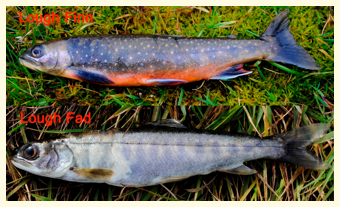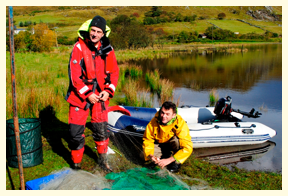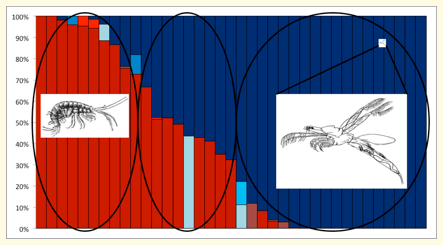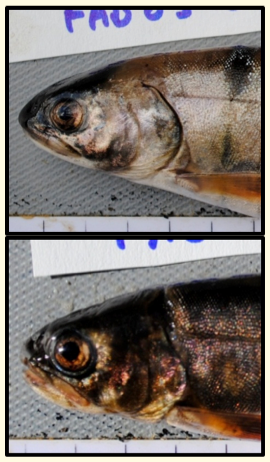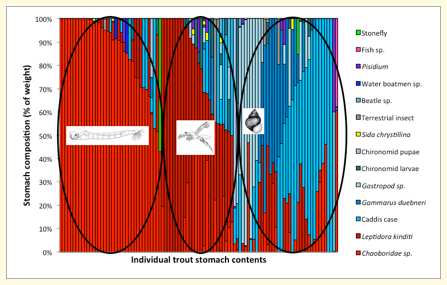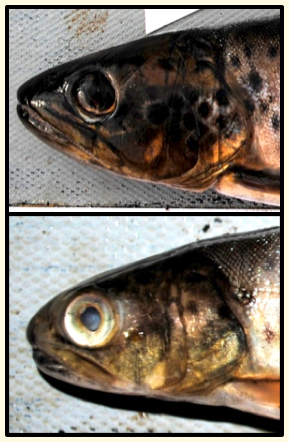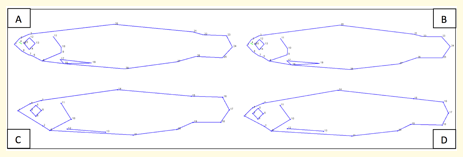| 15 |
Conservation strategies for rare freshwater fish |
| Following on from the article about his work in the last newsletter, Oliver Hooker writes: |
|||||
| Introduction |
|||||
| At present my work is concentrating on diversions in feeding ecology, the mechanisms behind these diversions and the consequences this may have on fish morphology, population dynamics, habitat choice and the implications this causes when planning effective conservation management strategies. Many fish species are specific in their feeding ecology, often concentrating on a single prey item. By specialising in the utilisation a specific resource or prey item through local adaptations, may allow an individual to become better suited to obtain that resource. This can allow an organism access to an otherwise un-exploited niche, out-compete competitors and reduce the time and effort spent searching for food. In turn the time and energy saved can be spent on other essentials, such growth, gamete production, mate acquisition and defending territory. So by specialising you can greatly increase your overall fitness Often these localised adaptations related to feeding can result in different morphology, predominantly in the head and feeding apparatus of an individual. These adaptations may then result in differences in phenotype. This can happen between locations (allopatric) due to differences in prey type, prey abundance, habitat and competition or within a location (sympatric) which is much less common. |
|||||
The two pictures here are a mature charr from Fad and a mature charr from Finn. These are the same species, but look very different as they feed on different prey items and use different types of habitat within their lough. |
||||||
| The cause of this dietary shift within a location may be the result of changes in the trophic system, thus understanding and studying morphology is important from a conservation perspective and provides an insight in to the functioning and health of an ecosystem. Furthermore these triggers are important to understand when assessing conservation needs; a change in diet has the potential to have multiple effects on a population. There can be direct effects on growth rates and thus what size a species becomes mature, fecundity, fitness, habitat use, body shape and due to this can play a functioning role in the initial stages of speciation. |
|||||
During my field work in the summer we were fortunate to find two lakes in Ireland, Fad and Finn (both in County Donegal) which have evidence of resource partitioning in two different species of salmonids, Arctic charr (Salvelinus alpinus) and brown trout (Salmo trutta) respectively. At present there are only 12 documented cases of polymorphic charr living in symaptry in the (approximately) 200 known charr populations in Scotland and this would be the first documented case of sympatric polymorphic charr in Ireland, of the 70 known populations. There are even fewer cases of sympatric polymorphic populations of brown trout, currently three in Scotland (not including the Ferox morph) and one in Ireland. What further increases the uniqueness of the trout population at Lake Finn is the possible sympatric population co-existing with ferox and sea trout. |
||||||
| Lake Fad |
|||||
| Lake Fad has a surface area of approximately ¼ hectare, an average depth of 7-8 metres and a maximum recorded depth of 14.9m. This is not only small in respect of most Lakes that contain Arctic charr but due to the shallow depth increases its susceptibility to water abstraction and climate change. At 323 metres above sea level it is the highest altitude charr population in Ireland and has a unique species composition as Arctic charr are the only fish species that reside in the lake. This alone raises the conservation value of this site. To add to this there is strong evidence of sympatric polymorphism, or the start of divergence within the population, another rare feature. Using stomach analysis it is clear there is a divide in prey type being consumed, with some individuals specialising in benthic prey items, some on pelagic and with what appears to be intermediate individuals suggesting this may be the start of divergence (fig 1). |
|||||
Fig 1 Prey composition of charr stomachs from Lake Fad, red and blue colours represent pelagic and benthic food items respectively. Two food items showed high levels of prevalence: - Leptodora kindti, a small pelagic invertebrate - Gammarus duebneri, a large benthic invertebrate. |
||||||
| The consequences of this specialisation has started having an effect on morphology with pelagic fish adopting pointier mouths and longer slender bodies, and benthic fish having shorter more robust jaws and shorter, thicker set bodies (Fig 2). |
|||||
Fig 2 Two Arctic charr from Lake Fad the upper charr specialises on pelagic food the charr below specialises on benthic food |
||||||
| Lake Finn |
|||||
| Lake Finn is approx. 2km long and ½ kilometre wide, average depth of approx. 12-14m and max depth of 21.6m. The fish community alone is of extreme conservation value. Not only can IUCN critically endangered European eels (Anguilla anguila) can be found here, but there are two different ecomorphs, the broad headed, piscivorous morph and the narrow head invertebrate feeding morph. It is also home to all Irish Salmonid species, Atlantic salmon (Salmo salar), Arctic charr and brown trout of which there are four morphs living in symaptry, the rare and declining sea trout, the ferox trout (a large piscivorous morph) as well as two morphs of the typified brown trout. This makes the icthyofauna at Lake Finn one of the most exciting and unique of those found in Ireland and extremely valuable from a conservation perspective The stomach analysis of Lake Finn is a little more complex than that of Lake Fad due to a more varied composition of prey items found but again there is a divide between fish specialising on pelagic and benthic invertebrates (Fig 3). |
|||||
Fig 3 Prey composition of trout stomachs from Lake Finn, red and blue colours represent pelagic and benthic food items respectively. Two different pelagic items were being heavily utilised: - Chaeoboris larvae and Leptidora kinditi, - whereas the benthic diets were somewhat more generalised. |
||||||
| The effect on morphology is much the same as that seen in the charr from Lake Fad, pelagic fish have adopted a more pointy head and longer, slender body whilst benthic fish have a shorter more robust head and stockier body and a more terminal mouth (Fig 4). |
|||||
Fig 4 Two brown trout from Lake Finn the upper trout specialises on pelagic food the trout belowspecialises on benthic food. |
||||||
| When different organisms adapt the same characteristics independently of one another the process is called convergent evolution, by manufacturing digitised images of these fish using individuals from the whole population you can see strong evidence of this process on the charr and trout for Lake Fad and Finn (Fig 5). |
|||||
Fig 5 Evidence of convergent adaptation The pelagic charr (a) and trout (c) have elongated bodies and pointier, narrow heads The benthic charr (b) and trout (d) have shorter, deeper bodies and stumpy, more robust heads. |
||||||
| Conclusion |
|||||
| Fish feeding at different trophic levels will experience different physiological repercussions. Diet can directly affect growth rate which in turn can affect predation rates on juveniles. Pelagic feeding fish in a population will often have an accelerated growth rate and reach maturity sooner, whilst benthic feeders often grow slower, mature later and reach larger sizes. This is not always the scenario as many other ecological factors can play a part in moulding the dynamics of a fish population. By maturing sooner you increase the number of times you can reproduce, as does living longer. Size is also an important factor as larger fish can produce and hold more gametes thus increasing fecundity. The benthic charr found at Lake Fad had a significantly higher fat content, and although there was no significant relationship between diet and fecundity, there was a positive correlation between fat content and fecundity. Changes in feeding ecology can be a strong catalyst for the early stages of speciation, an area of natural science which still needs better understanding. This process can be triggered in various ways of which the two of the strongest of those of positive assortative mating and habitat segregation. Positive assortative mating is the process where individuals actively seek out and reproduce with an individual that shares a similar phenotype, so to simplify; pelagic feeding females are more likely to spawn with pelagic feeding males as they are similar in appearance (morphology, size and colour) likewise with benthic feeding fish. This coupled with habitat segregation as pelagic feeding fish will use different areas of the habitat at different times to that of a benthic fish due to prey ecology, results in different fish in the same population being pushed in two different directions in relation to their life history. When this divergence reaches a critical stage that spawning is effected (especially in relation to timing) then populations may become genetically isolated, this is the initial stages of speciation. All of this information is important from a conservation perspective, • it provides details of how delicate a population might be • allows assessment of the health of a population • how well it may recover from poor recruitment • the potential said species has to adapt to other habitats • what habitat is used and therefore prioritise what may need protecting and how i.e. abstraction may leave crucial spawning or nursery areas unreachable during critical periods • gives indications to the stability/health of an ecosystem and changes in the trophic sector • the need to protect unique populations or those of high scientific interest • not only conserve rare fish but also rare fish communities/combinations Further analysis planned for the near future is ageing individual fish to establish growth rates between benthic and pelagic feeders, stable isotope analysis to get a finer temporal understanding of individual feeding habits as prey abundance and type can fluctuate heavily over time and genetic comparison of phenotypes to establish is there is any isolation of gene flow caused by positive assortative mating and habitat segregation. |
|||||
IBIS newsletter March 2013 |
||||||

